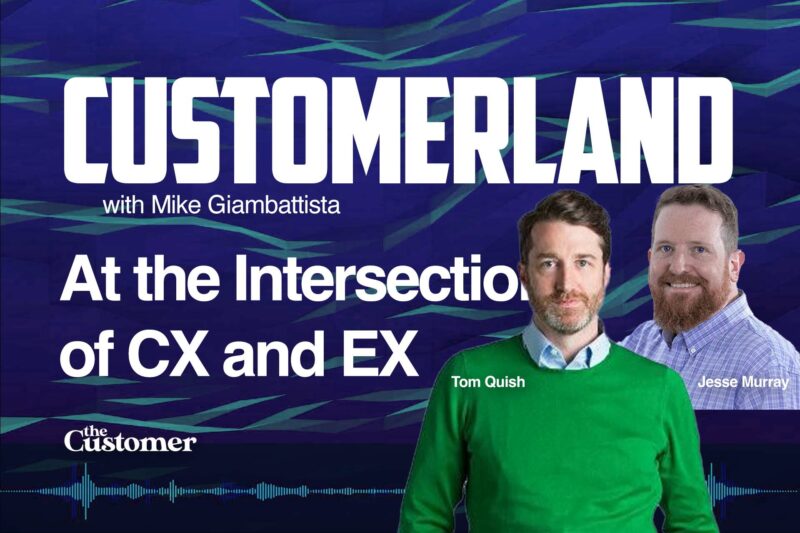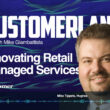Know what one of the main factors behind an effective CX effort is? (Hint: it’s EX) Know what it takes to move the needle on enterprise-wide CX initiatives?
In this episode of Customerland, we sat down with Tom Quish, SVP of Customer Experience at Rightpoint, and Jesse Murray, Rightpoint’s SVP of Employee Experience to continue a conversation we had begun at this years’ NRF conference. If you aren’t aware – and I wasn’t – both Tom and Jesse are the dual embodiments of passion and expertise as it relates to CX and EX respectively – and how those two concepts combine to reinforce and support the other.
Plus you’ll learn when and why so many CX/EX initiatives never get out of the gate and what you can do to make sure that doesn’t happen to you.
Also, a special shout out to Verint – our sponsor for this episode.
Full Transcript Below
Mike Giambattista:
Jesse Murray, right points SVP of E Employee Experience, along with Tom Kush, SVP of Customer Experience. At right point, we’re picking up on a conversation that we, we had a robust conversation at N R F wanted to talk about what it takes to make enterprise CX happen as well as ex if we can lump those two together for, for this part of the conversation without offending anybody.
Jesse Murray:
No, absolutely. I mean EX is the internal version of cx, so they’re, they’re not really disconnected from each other as much as I think the conversations might. I’ll start with executive buy of CX investments for hundred. I think this, this area on the ex side, you know, I’m always arguing about roi, why investing in employees and what have you. It, it was surprising to me when I was talking to Tom when we were at CX North America last year, how open the conversation is of whether CX is value. From the ex perspective, CX is the easier to value portion of that discussion because it’s typically tied to revenue. Or at least my, my perception was that it would’ve been tied to revenue or a business outcome. You know, Tom, I think you can probably share that, that maybe isn’t always the case. And, and I think making sure that we have alignment on that value story, why, why CX matters, what it’s doing for the business, why ex matters the same way. I think that’s really the, the, the big one for me.
Mike Giambattista:
So are, are you saying that at CX North America last year, there was still some dispute as the value, as the value of cx? Is that
Jesse Murray:
Correct? There, there were a couple of topics there. One of the more recent conferences I forget the one but it was the end of last year. Same thing, like how do you value cx Forrester still publishing, like how do you determine the value of cx? So I, I think that’s still out there. I, I don’t think we’ve, I don’t think we’ve put that to bed on not saying what the value of CX is. And, and why
Mike Giambattista:
Is, is it just, were those, I’m just curious, were those conversations or comments just a function of the metrics we use, or was it, was it more to do with like, why should we bother with CX at all?
Jesse Murray:
I don’t know that it was the metrics as, as much as I, I think it a misunderstanding as to why they weren’t, why those investments weren’t realized in the roi. Interesting. I, I think one of the other things we talked about ATF is that what you’re, what’s a critical technology? It, it, it really doesn’t come down to the technology. It comes down to whether you realize the value of any of those technologies. And I think the, the interesting thing about kind of ex and CX conversationally being separate is one of the reasons why we see a lack of CX ROI realization. You can buy any CX platform technology solution that you want. If you don’t empower your employees to use that technology or solution, then you’re not gonna get the value. And, and I think that’s probably where the issue is. It’s not necessarily like, there isn’t an understanding of how to measure CX roi, that, that they’re not getting the ROI of their CX investments. That I think that might be where that challenge is.
Tom Quish:
I, I don’t know, maybe changing the topic slightly, but still kind of tangentially, <laugh> on topic in some ways. Jesse and I met with a handful of CX leaders, actually just so happened to be last night over like a wine tasting type of event. And it was interesting. One of the, one of the questions that we, you know, opened up to the group around was the idea of, you know, if you could describe your cx for your organization in one word, what would it be? And like, I, I have copious notes, but like, generally the sentiment was fragmented, disconnected, spotty, or in the process of like transitioning or transformed, you know, transformation. So, you know, these are big, you know, corporations who have, you know, loyal customer bases that still feel like, you know, just internally their efforts have been, you know, siloed or, or fragmented in some ways.
They feel like in certain aspects there are, you know, measurable and trackable elements of the customer experience that they can, you know, provide that ROI story around. And then there’s other areas where they haven’t gone as far on implementing programs and practices to actually enhance or optimize that customer experience or, you know, don’t have the, the tagging involved to be able to, you know, track the the return. So it, it’s interesting. I think there’s, like, everybody’s on their own journey, you know, as an organization. And I think again, even talking to these different groups across different industries, the, the general sentiment was, you know, hey, we’re trying, we’re spending a lot of time and energy doing these things. We’ve, you know, invested in these technologies. We’ve, you know, tried out different solutions and different ways of working. And we still feel like, you know, our customer experience is, is spotty or disconnected.
So to me, I think, you know, what it comes down to is that on the employee side, that ability for leaders to come together. So, you know, the, the established partnerships between C X O, the C M O, the C O C O C F O, like all the things that we talked about at nr nrf so those folks coming together and kind of aligning on that holistic strategy to kind of diffuse some of those silos that have been, you know, cropping up in those organizations and really sort of sharing that idea of customer experience across the organization. And I think, you know, when everybody feels like they’re somehow sharing an ownership of that customer’s experience on the employee side, I think, you know, those are the organizations that you see celebrated for having tremendous cx I, you know, customers themselves.
Mike Giambattista:
You’ve just prompted another 30 questions, which is gonna fully derail this conversation. <Laugh>, sorry.
No, no, it’s, it’s, I think it’s all really, really rich stuff to be talking about. And I, I don’t wanna leave the, the, the comment that that you made Jesse a moment ago, that, that if there is a, the key to this, to the success of a CX e except it’s the ex executive sponsorship, because that’s, and that can look like a lot of different things. I was talking to one practitioner, fairly well-known guy in the space who said that he has walked away from projects, fairly large ones, because it wasn’t the c e o who was behind it. I mean, you know, there’s one, there’s, there’s one thing to endorse something by signing your name on the bottom line of the, of the initiative. But there’s another one where it’s an enthusiastic kind of, let’s get the team on board and let’s everybody do this thing. And and that seemed to be what he was saying is like, it just takes that kind of, of kind of, you know, team enthusiasm to pull this off because, well, we all know because there’s, there are lots of reasons it’s complicated. ROI tends to be longer term harder to track and all those kinds of things. So, and there’s always somebody trying to sell you technology to solve it.
Jesse Murray:
I think one of the things that jumps out at me there ceo I, I think you’d ask the question like, what’s a predictor of success with CX and ex visionary CEO or visionary c xo? And, and I say that cuz particularly visionary cx o that we talked about yesterday and wanna get his words right here we cannot have great customer experience without great employee experience, period, right? And it takes that level of executive buy it, there’s an energy behind there, there’s a behind that, right? And so your teams will rally behind that type of vision. And I, and I I agree visionary CEO probably the easiest indicator of success of any, any, any reasonable scale transformation because ROI does take a while. And these things are hard. And there’s a lot of technology issues in the way, right? Like, and there’s a lot of data issues in the way it takes time to do that. And it does take that purpose. And, and I think just, I, I can’t agree with that more.
Mike Giambattista:
It, it’s unfortunate that you really don’t find out upfront how much of a visionary your CEO is until you’re kind of deep into the conversation. And in fact, that’s what this, this same person was kind of lamenting is that, you know they’re in full pitch mode. When it becomes clear that the CEO is not really fully bought in, then they kind of pack up and leave, or, you know, you have to get fairly deep into a conversation before you really understand, you know, how enthusiastic the C-suite really is about stuff like this. So there, there doesn’t seem to be some sort of like public facing metric you can look at. It’s just a, it’s almost a personality driven thing.
Jesse Murray:
Yeah. And I think it, it’s also a prioritization thing, right? What, what level of importance is this? Does it top three initiatives this year? Is it top 25 initiatives this year? Right? That’ll tell you a lot about, right, how important and how critical it’s, and how, and how much energy the organization’s gonna be able to put behind it. And I think that’s that much more than what technology they have or do they have the right skillset or, or anything like that, that, that much, much more predictive of, of success or failure.
Mike Giambattista:
I, I don’t know if I mentioned this at N R F, but and if I did, and it’s old news, just kind of wave me off here, but we, we did a study about a year and a half ago, almost two years ago at this point, to try and gauge the CX seriousness from the Fortune 50. And the way we did it was we looked at their 10 queues and 10 Ks over the past 12 months looking for clues as to whether they have a cxo, whether they’ve promoted somebody into the CX O position or something similar, whether the, the, whether the term CX or customer experience even makes it into the narrative for them. And, you know, yeah, that’s kind of a squishy metric. It’s, it’s, this is not a hard metric at all, but we’re look, just looking for some indicator because everybody likes to say they’re customer centric and, you know, you’ve got some CX effort on some level, but do you really, or is it just another, you know, X initiative?
And what we found out was an it was, it was right close to 10% of the Fortune 50 had something they were putting out publicly that, that kind of their stake in the ground were going for you know, an overhaul, if you will, of their, of customer experience. And along with that, there were a few mentions of employee experience, but that was really telling to me because, you know, the Fortune 50 that meant that, that if my number’s right, that five companies out of the 50 were really all about it. And the other 45 were either not mentioning at all, or it was kind of just, you know the, the, the marketing buzz you your, yeah. Right. So I don’t know what your experiences are, if, if you, if you think that holds true for the people you talk to.
Tom Quish:
Yeah, I think, I think for the clients that we work with in, in some cases we’re brought in via like an employee experience conundrum that they’re facing, and then we expose opportunity to, you know, have that employee experience help support a, a broader customer experience initiative. In other cases it’s, you know, it’s, it’s fully blown sort of, Hey, we, we need help in support of our customer experience. How can you help sort of identify the pain points and the opportunity areas and, and help us sort of optimize or, you know, in, in some cases, reinvent our, our customer experience. So it kind of, it, it depends on who we’re talking to and, and where they are on their sort of organizational journey. But yeah, I mean, I, I’d say, you know, largely the focus of our clients or the clients that come to us is, is, you know, that they realize that there is a benefit in investing customer experience, and they are trying to reap that benefit.
Again, in some cases, so maybe in one example where, you know, say it’s a, a marketing experience that we’re helping to craft and, and launch part of that, you know, while it has a customer facing sort of outcome and output, I think part of that is considering like, what is the marketing team’s role in sort of populating this experience and how do we ensure that their job is easier, their ability to connect and engage with their customers is, is ultimately, you know, simpler so that they can create a better end customer experience for you know, their target audiences. So I, I think largely we see, you know, both sides of that coin coming to bear in terms of the conversations that we’re having with our, with our clients.
Sponsor Message
This episode of Customer Land is sponsored by Verint, the customer engagement company. Verint helps the world’s most iconic brands build enduring customer relationships by connecting work data and experiences across the enterprise. Verint has conducted research over the past three years and found that a chasm exists between what organizations know they need to do to meet rising customer expectations and the resources they have to actually do it. It’s called the engagement capacity gap to help bridge that gap. Verint empowers businesses to effectively listen to customers, analyze both strategic and individual level data act to engage customers and deliver differentiated experiences at scale, ready to expand what’s possible and close the engagement capacity gap at your business. Learn more at Verint.com. That’s V E R I N T.com.
Jesse Murray:
And it reminds me of one of the conversations we had at rf. So I’m a technologist by trade but most of our success doesn’t really come from tech. It comes from application of tech to a person very specifically. NRF was a lot of tech. Yeah. and I think that’s kinda the experience that we see all over the place is by this tech, this tech will solve your problem by this tech, this tech will solve your problem. It it’s not about that. It, it, you know, most frankly, most of our customers own plenty of tech and, and frankly, too much of it. And they never really took the time to kind of align the tech to user needs. And, and they also don’t oftentimes integrate the tech with other tech,
Mike Giambattista:
Right?
Jesse Murray:
So the, the integration that we find, and this is actually probably one of those indicators of inability to execute a large ex CX transformation. If your people, if your employees are your systems integration layer, then you’re not really going to be able to transform a lot. They’re, they’re working at the behest of the tools instead of the other way around. And that, and that almost always shuts things down in, in the conversation last night data was a common theme. All these systems, none of which talked to each other. So if you wanted to follow a customer all the way through their systems, a customer was known by this in one system, customer’s known by this on another system, and then you flip it to the employee side and the exact same thing, all these different systems of disconnected data only, only the people that do the work can go through and what are they doing then?
Not providing customer experience, right? Not investing in, in better customer service. They’re just struggling with technology and I, it, it is in my career, probably one of the most frustrating things is that we just haven’t put to bed making our tech stacks work with each other properly. Or, or even moderately. And, and so I just, I’ll stay off my soapbox here, but I, I think every time I go to a conference and I look at at 700 booths of buy my tech I I’m reminded why we are in the situation we often are,
Mike Giambattista:
Well, I have to, I have to walk gingerly here because those tech people keep our lights on here. So
Jesse Murray:
<Laugh>, I mean, I do love some tech too. I’m a technologist,
Mike Giambattista:
But for the record, I love tech too. But, but I, I remember, I think it was statement that, that you made, Jesse, I think it was you, like, tech will not solve your CX problem. I, I think it was that point blank. And, you know, there’s a lot to be said there. There’s a lot to, I mean, frankly, you could, you could make that same case about you know, tech is not gonna solve your marketing problems. Tech is not gonna solve your HR problems. So tech, it just isn’t that way. And that kind of points to the thing that I’m, that I’m, I’m really hoping to open up with both of you, which is that so much of what Right point does, and U2 specifically seems to be about change management at a corporate level, at a cultural level, and that’s ridiculously hard to implement. I mean, that’s, that’s just tough. You’ve got, I mean, you’ve got culture that, and that that will resist it. You’ve got protectionist borders, you’ve got the inbuilt silos, you’ve got all kinds of motivations and KPIs and bonuses that say they don’t want to change. And you’re saying, well, we need to, if we’re gonna get there, and by the way, I’ll show you an ROI down a line somewhere. I’m simplifying it, but, but how do you, how do you, as two people who who lead these charges, how do you do that?
Jesse Murray:
You wanna take that first time? Or you want me to jump
Tom Quish:
Go, go ahead and I’ll, I’ll riff off of what you said.
Jesse Murray:
So the, the first thing that, that we go is to look to whether you have an understanding of your customers and your employees first. Have, have you done the analysis to understand what their, who they are and what their motivations are. Do you know how they spend their day when a customer comes in, do you know what happens internally? Do you know what kind of processes that kicks off? You know, classically service design, journey mapping, personas we’re, we’re pretty big about mapping value into that journey. So you can see when this, this challenge happens, you’re, you’re seeing a decrease in customer nps, so address and prioritize investing in this place, but it’s, it’s really about shining light on, on what a lot of places don’t have. They don’t have a cohesive journey. Oftentimes you’ll see a customer lifecycle journey.
You’ll see an employee lifecycle journey as if they are too disconnected things and they’re really not right? Like, you have to go deep into the, under the, all the way into operations of a customer journey map to really understand what’s happening that’s causing their frustration. It very well could be a systems issue from a vendor right, that you’re there, but you oftentimes we just don’t see that visibility. So I, I think for me, it’s, it’s start with an understanding of customers, employees and see if we’re rooted in that first, and then we can suss out your pain points and your technologies and process changes of data that goes around that.
Tom Quish:
Yeah, I’d say, and one of the things that we had talked about with, with an individual who sort of sat within kind of a merge role within ex Ncx even in our, our recent conversations, one of the things that we had talked about was, yeah, you might have some sense of what the customer’s journey is or pockets of understanding of, you know, different areas of opportunity. But overlaying that with the employee experience and how your employees have to kind of get through their days and do their, you know, work their shifts or, or, you know, perform their tasks sometimes that allows for, you know, a more unique perspective on how you can better the customer experience by again, solving some of those employee related experience issues. Yeah, no, I, I think, I think that’s a good point, Jesse. There’s that sort of understanding that, you know, under understanding happens in pockets sometimes.
And again, to get back to the fragmented sort of CX thought in certain, in, in terms of some of the responses that we got in our conversation just the other day a lot of that was sort of, yeah, we’re doing it in pieces and pockets, or we have this area of the journey mapped out really clearly, but then other areas are, you know, a little bit blind to us. And so it’s just drawing that focus, driving that focus within the organization to really flesh out those more complete and holistic journeys that showcase sort of where employee experience and cx start to intersect and, and how you can better both sides in that way
Jesse Murray:
To
Mike Giambattista:
Your, I’m just curious, I’m sorry, just real quick. When you’re at that point in a conversation with one of your clients, you’ve, you’ve done kind of the, the first level of digging to, you know, I’m, I’m gonna fake it and call it a SWOT analysis of, of where the problems are, where the opportunities are. Is that, is that an executive level presentation or by that, by that time, are you down within the divisions and the, you know, kind of upward maybe middle management people that are actually pulling the levers and pushing the buttons on
Jesse Murray:
This? It is interesting. Ideally we started at the executive level conversation. We definitely are going to go down into the organization and gather all this data and then you’re gonna pull back up into an executive level conversation. Cause at the end of the day, no matter who you’re talking to, there’s gonna be a larger list of pain points than you are going to have budget or time to resolve. Yeah. and we have to get that back up into a, a business outcome lens and a prioritization discussion. It, it is what is most impactful? Is it, is it higher employee retention? Is it more revenue? But you have to put that business lens over top of the pain points and run through that prioritization exercise to figure out where should we be making changes soonest. I think we’ve all just accumulated a lot of experience debt over the years because we have all these little initiatives all oftentimes broken up from each other, or what was it fragmented was the word of the day yesterday, Tom. They’re fragmented and we, we have to pay that off now. And that, and I think that’s frankly why it’s so hard because you, you, if you look at everything that’s broken and they’re like, I dunno where to start, but if you take a, if you take a business outcome lens to it and prioritize and say, what are we going to do? Let’s, let’s get this part better and it made this better, and this is the value that we got, and take that approach, then you can kind of work your way through that.













